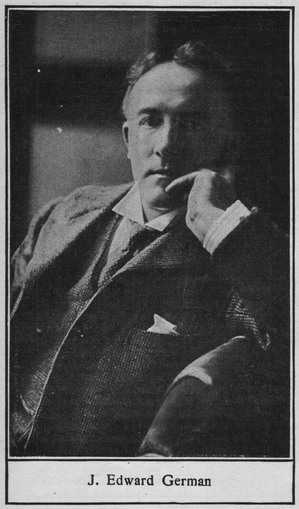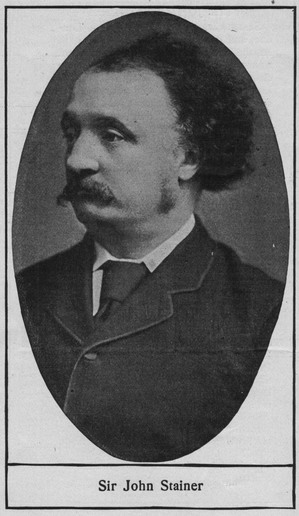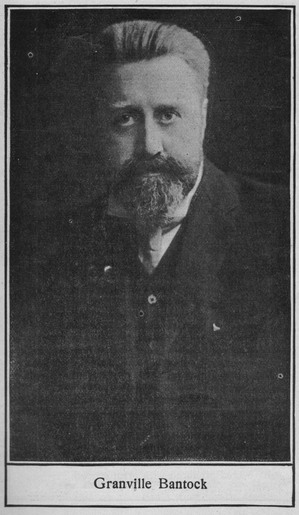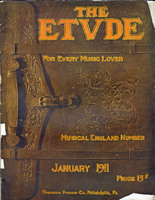German was born at Whitchurch, February 17, 1862, and was educated at Chester until 1878, when he returned to Whitchurch, and organized a local band. A little music study in Shrewsbury followed, but in 1880 he went to the Royal Academy of Music, where he studied under Dr. Steggall (organ) and Weist-Hill and Alfred Burnett (violin). His operetta, The Rival Poets, was produced while he was at the Academy, where he afterward became a sub-professor of the violin. After spending a year earning a living as an orchestral violinist, German was appointed musical director at the Globe Theatre, under the management of Richard Mansfield, in 1888, and his first great opportunity came when he was commissioned to provide incidental music to Richard III. From that time on similar commissions were entrusted to him, and his work became increasingly popular. His most notable achievement in the way of incidental music is perhaps the suite of dances to Henry VIII. At the same time, however, he kept up work of a more serious kind, and his Symphony in E minor was produced at the Crystal Palace in 1890, and other similar works have been produced since. When Sullivan died in 1901, leaving the Savoy opera, The Emerald Isle, unfinished, German undertook to complete the work, and did this so successfully that he also wrote the music to the next two productions, Merrie England and A Princess of Kensington. His songs are deservedly very popular.
Stainer was born June 6, 1840, in London, and died in Verona, March 31, 1901. At the age of seven, being an excellent sight-reader and able to play well, he became a chorister at St. Paul’s Cathedral, London. His musical education was assisted by Dr. Steggall, Bayley and George Cooper. In 1859 he matriculated at Oxford, and took the Mus. Bac. degree. Shortly after he entered St. Edmund’s Hall, Oxford, as resident undergraduate, acting as organist at Magdalen College and proceeded to his B. A. degree. His work here was very much appreciated, and Stainer held various appointments at the University until 1872, when he succeeded Goss as organist of St. Paul’s, London. He continued his work as an educator, however, and became associated with various examining bodies, and held such positions as examiner for musical degrees at London University, Vice-President of the College of Organists, Inspector of Music in the Elementary Schools of England. Failing eyesight obliged him to resign from St. Paul’s in 1888, and a year later he was appointed Professor of Music at Oxford University. At the same time he received the honor of knighthood. His best known compositions are The Crucifixion and The Daughter of Jairus, besides many anthems, church services, hymns, etc. His works on Harmony, Composition and The Organ are among the best of their kind in existence. His greatest excellence was his organ playing.
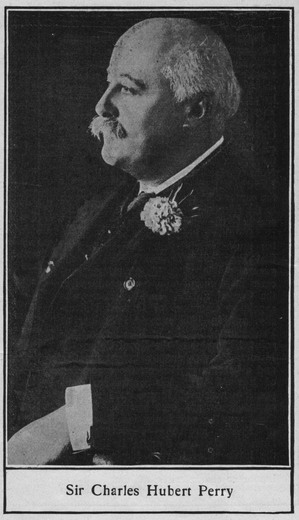 SIR CHARLES HUBERT HASTINGS PARRY.
SIR CHARLES HUBERT HASTINGS PARRY.
Parry was born at Bournemouth, February 27, 1848, and was educated successively at Malvern, Twyford, Eton, and Exeter College, Oxford. His musical ability was early shown, and was fostered by association with Samuel S. Wesley at Twyford. Later he studied with Sterndale Bennett and G. A. Macfarren. At Oxford he founded the University Musical Club, and occasionally took part in notable musical events. On coming down from Oxford he entered the firm of Lloyd’s, but after three years he adopted the career of a musician. He owed much to the friendship of Edward Dannreuther, and at the semi-private meetings at Dannreuther’s house, much of his chamber music was played. It was in 1880 that Parry first became known to the general public, when his pianoforte concerto in F sharp minor was produced at the Crystal Palace. In 1883 Parry was appointed Choragus of Oxford University, and in 1900 succeeded Stainer as Professor of Music; in 1894 he was appointed Director of the Royal College of Music. He was made a knight in 1898, and a baronet in 1903 on the coronation of Edward VII. His works are composed in nearly all forms, but his choral compositions are best known. Among these may be mentioned his Blest Pair of Syrens and The Pied Piper of Hamelin, the one because it illustrates the loftiness of Parry’s ideals, and the other because it displays the geniality and humor so characteristic of him.
Bantock was born in London, August 7, 1868. It was originally intended that he should enter the Indian Civil Service, but his musical proclivities were such that this idea had to be abandoned, and after a few lessons in harmony and counterpoint from Dr. Saunders at Trinity College he studied at the Royal Academy of Music, 1889. He was here a pupil of Frederick Corder, and won the Macfarren Scholarship after his first term. Two or three of his works were produced at the Academy concerts, notably his overture, The Fire-Worshippers, which was also produced at the Crystal Palace. After leaving the Academy he became editor and proprietor of The New Quarterly Musical Review, and acted as conductor of light opera and musical comedies. In this latter capacity he made the tour of the world with one of George Edwards’ companies in 1894-5. In 1895 Bantock conducted Stanford’s Shamus O’Brien on its provincial tour. Three years later he was appointed musical director at the Tower, New Brighton, where he did great work for English music. In 1900 he became Principal of the Birmingham Institute School of Music, later succeeding Elgar as Professor of Music at Birmingham University. His compositions are rapidly attracting world-wide attention, and Bantock is a recognized leader of the “younger” school. His setting of Omar Khayyam and his Pierrot of the Minute have been produced with great success in America.
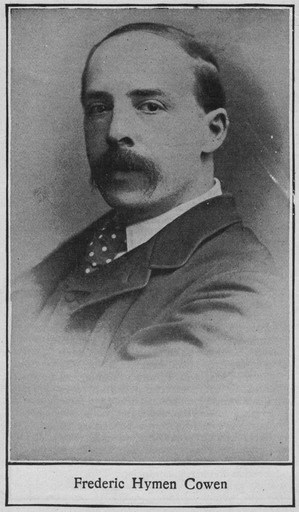 FREDERIC HYMEN COWEN.
FREDERIC HYMEN COWEN.
Cowen was born at Kingston, Jamaica, January 29, 1852. He was taken to England at the age of four, and composed a waltz at the age of six. Two years later he composed an operetta to his sister’s libretto, and his musical education was more systematically undertaken. He became a pupil of Goss and Benedict, and eventually went to Leipsic, where he became a pupil of Plaidy, Moscheles, Reinecke, Richter and Hauptmann. Owing to the Prussian-Austrian war, however, he was obliged to return to England, where he appeared in concert as a composer. In 1867 he entered the Stern Conservatory in Berlin, and became a pupil of Kiel. On his return to England he appeared at the Philharmonic concerts, and at the “Monday Pops,” etc., both as composer and pianist. In 1869 he appeared at the St. James Hall, and his symphony in C minor and concerto for piano and orchestra in A minor were both given. From that time on he was recognized as a rising man, and became accompanist to Mapleson’s concert party, and assistant-accompanist to Costa at Her Majesty’s. Through Costa, Cowen got his first festival commission, and his Corsair was brought out at Birmingham in 1876, and the same year his opera Pauline was produced. He has written much in all styles, and seems to be able to write anything from a popular ballad like The Better Land to the Scandinavian Symphony, which made him famous in 1880. He is at present conductor of the London Philharmonic Society.
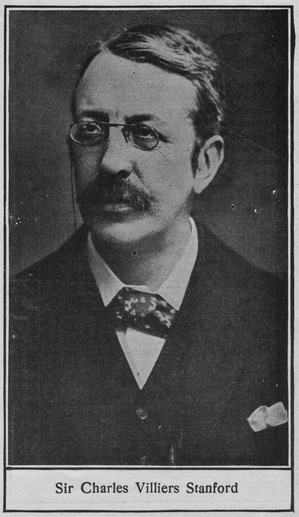 SIR CHARLES VILLIERS STANFORD.
SIR CHARLES VILLIERS STANFORD.
Stanford was born in Dublin, September 30, 1852. His early education in music was conducted by Sir Robert Stewart and Arthur O’Leary, but in 1870 he matriculated as choral scholar at Queen’s College, Cambridge. In 1873 he “migrated” to Trinity College, where he became organist in succession to Hopkins, and graduated in 1874 in Classical Honors. He was also given leave of absence each year, from 1874 to 1876, in order to study at Leipsic with Reinecke, and at Berlin with Kiel. In 1876 Tennyson’s Queen Mary was produced at the Lyceum Theatre, and Stanford wrote the incidental music. This, together with a symphony produced at the same time, attracted considerable attention, and Stanford has been before the public ever since. At the same time his work as conductor of the Cambridge University Musical Association much enhanced Stanford’s reputation. In 1885 he was elected Professor of Music at Cambridge University, and did much to reorganize this sadly-neglected department of study in Cambridge at that time. On the opening of the Royal College of Music he was appointed Professor of Composition and conductor of the orchestra. His compositions are of all kinds, including several operas (notably Shamus O’Brien), cantatas, symphonies, concertos, chamber music, songs, anthems. His choral ballad, The Revenge, is very popular in England. Stanford was knighted in 1901.


